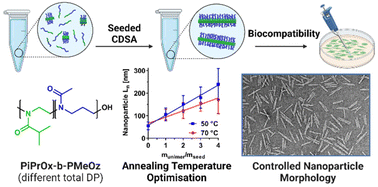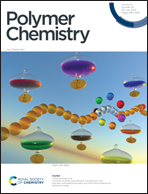Length-tuneable biocompatible block copolymer nanorods with a poly(2-methyl-2-oxazine)-corona via heat-induced crystallisation-driven self-assembly†
Abstract
Polymer-based nanoparticle (NP) morphology and surface chemistry are important factors to consider when it comes to their stability, biocompatibility, and biodistribution. Poly(2-oxazoline)s and poly(2-oxazine)s have been shown to exhibit favourable physicochemical properties for use in polymer-based formulations in the context of drug delivery, as have rod-shaped NP morphologies. However, the formation of rod-shaped NPs with a high degree of morphological consistency often represents a synthetic challenge, and is yet to be reported with the use of poly(2-oxazine)s. Herein, we show the first poly(2-methyl-2-oxazine)-based rod-like length-controlled NPs, obtained through heat-induced seeded crystallisation-driven self-assembly (CDSA) of novel poly(2-isopropyl-2-oxazoline)-block-poly(2-methyl-2-oxazine) (PiPrOx-b-PMeOz) block copolymers (BCPs). PiPrOx45-b-PMeOz47, and PiPrOx91-b-PMeOz74 are synthesised to probe the relationship between total degree of polymerisation (DP) and seeded CDSA kinetics. To this end, a novel method for the optimisation of seeded CDSA via1H nuclear magnetic resonance spectroscopy is used, determining the differing rates of spontaneous and seeded crystallisation of these polymers in situ. PiPrOx-b-PMeOz NPs are subsequentially contrasted against previously reported poly(2-methyl-2-oxazoline)-block-poly(2-isopropyl-2-oxazoline) (PMeOx-b-PiPrOx) NPs in vitro with regard to their bio-nano interactions. PiPrOx-b-PMeOz NPs demonstrate high biocompatibility, and increased cellular association relative to PiPrOx-b-PMeOx NPs, independent of their total DP. This work demonstrates a significant improvement in the optimisation of heat-induced seeded CDSA and highlights PMeOz as a biocompatible polymer material with potential for use in a therapeutic context alongside materials such as PMeOx and poly(ethylene glycol) (PEG).

- This article is part of the themed collection: Pioneering Investigators 2023


 Please wait while we load your content...
Please wait while we load your content...